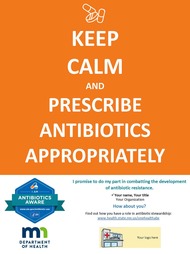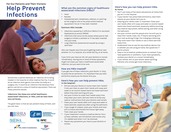 Keeping Clostridium difficile (C. diff) in check is a challenge for long-term care facilities, but well worth the effort!
C. diff is a germ that causes major colon inflammation and deadly diarrhea. The CDC estimated C. diff is the cause of almost a half-million infections in the United States in 2011, and 29,000 died within 30 days of diagnosis. Infections caused by C. diff are among the most serious healthcare complications that impact nursing home residents.
MDH has developed a new toolkit which focuses on evidence-based recommendations and standards for the prevention and management of C. diff infections in long-term care. The strategies include:
- Preparing your facility to care for residents with C. diff infection.
- Appropriate identification and surveillance practices that drive prevention and control efforts
- Care for residents with suspected and/or confirmed C. diff.
- Assessment and implementation of environmental cleaning
- Prevention activities such as antibiotic stewardship and proper treatment of C. diff.
- Staff and patient education and resources
Read more: Clostridium difficile Toolkit for Long-term Care Facilities
|
 Antibiotic Stewardship
Commitment Toolkit
MDH has expanded the Antibiotic
Stewardship Commitment Toolkit, which can be used across the continuum of
care. Find posters that can be customized with your facility logo, prescriber
names and photos, or even patient photos. Commitment posters have been shown to
improve prescribing practices, and they provide a great way to discuss
responsible antibiotic use with patients and families.
Summary Report: 2017 MN Clinic
Survey of Antibiotic Stewardship Practices
MDH
conducted a survey to assess current clinic commitment to antibiotic
stewardship, learn about stewardship activities, identify barriers, and define
stewardship resource and support needs.
Nearly
half of surveyed clinics have not made a formal commitment to stewardship or
developed a stewardship policy. Minnesota has room for
improvement in use of stewardship interventions, such as watchful waiting, use of
treatment guidelines, and providing patients with antibiotic alternatives.
MDH Antibiotic
Stewardship Clinic Survey Summary Report (PDF)
|
Summary Report: 2018
MN Community Pharmacist Survey of Antibiotic Stewardship Practices
MDH
partnered with the MN Board of Pharmacy and MN Pharmacists Association to
ascertain the level of commitment to antibiotic stewardship among community
pharmacists. The survey also assessed the inclusion of stewardship activities in daily workflow, barriers to implementation, and resource and support needs.
Survey results showed that 25% of
pharmacists educate patients on AS and AR and 10% of pharmacies have an AS
policy. This shows that there is room for improvement in AS within Minnesota’s
community pharmacies.
2018 Antibiotic Stewardship Practices in Minnesota Community Pharmacies Survey (PDF)
Community Pharmacists: Essential Partners in Minnesota Antibiotic Stewardship (PDF)
New Guidance Document for Long-term Care Stewardship
With partners from Minnesota's Antibiotic Stewardship Collaborative and beyond, MDH has developed a guidance document called Using Electronic Health Records for Antibiotic Stewardship (PDF).
The document is intended to support facilities to use electronic health records to drive action and facilitate antibiotic use tracking and reporting.
Antibiotic Stewardship in Ambulatory Care Conference Materials
Slides presented at the May 1, 2018 conference are now archived online: Annual MN Antibiotic Stewardship Conference: Focus on Ambulatory Care.
The agenda included national and Minnesota-based speakers and covered issues across ambulatory care, including general practice, dentistry, and emergency departments.
Do you work in an ambulatory care setting? Are you
passionate about antibiotic stewardship? MDH is creating an advisory group
specific to outpatient antibiotic stewardship (AS). This workgroup will share
insights on AS needs in ambulatory care, identify priorities for support,
review new and existing MDH resources and tools, and promote awareness of these
materials by providers and facilities. If you are interested in joining us,
please contact health.hai@state.mn.us.
While Hand Hygiene Day was officially celebrated May
5, it's never too late to recognize that being a champion for hand
hygiene saves lives! Orlaith Staunton, co-founder of the Rory Staunton
Foundation for Sepsis Prevention, became an advocate for handwashing after her
son scraped his arm playing basketball. The coach did not wash his hands or
clean the wound. Four days later, her son died from sepsis despite going to a
pediatrician and the hospital.
Read more: CDC's
Safe Healthcare Blog: A Back to Basics Approach to Prevent Infection.
Choosing the right place to receive health care can be a
daunting task for consumers. To help consumers make the right choice, The
Centers for Medicare and Medicaid Services (CMS) provides information about the
quality of care at Medicare-certified hospitals across the country on the Hospital
Compare webpage. Hospital ratings help consumers make decisions
about where to get health care and encourage hospitals to improve the quality
of care they provide.
A provider's overall star rating is based on several
measures. One of the categories used in the ratings is "Safety of Care."
This category measures complications, deaths, and unplanned hospital visits,
some of which are due to HAIs. The HAI measures show how often patients in a
hospital contract infections during treatment.
CMS publishes National Healthcare Safety Network (NHSN) data on HAIs on Hospital Compare. The public
reporting of these data on Hospital Compare is part of a movement by the
Department of Health and Human Services to make health care safer.
Learn more: Medicare.gov:
Hospital Compare
 A new patient education guide to help prevent HAIs is
available in both Spanish and English at no charge (provided no changes are
made) on the SHEA website. The guide was developed by CDC with input from APIC,
SHEA, IDSA, the American Hospital Association, and the Joint Commission. It
covers what patients can do to help prevent an HAI, common signs of an HAI, and
what patients need to do if they have one.
Learn more: SHEA:
Patient Resources
|
Included among the many CDC materials is the “DentalCheck
App,” which helps dental health care professionals assess their own office
policies and practices for optimal infection control.
Learn more: CDC: Infection
Prevention in Dental Settings
Are you part of, or do you know a health care team that's doing great work to reduce the incidence of infections or combat antibiotic resistance?
If so, CHAIN would like to hear about it and recognize the excellent work being done like:
- Involving patients or residents and their families in your work to reduce infections or enhance antibiotic stewardship
- Launching an antibiotic stewardship program, with early successes to share
- Ramping up your infection control program by enhancing surveillance, improving testing practices, or finding creative ways to promote best practices for prevention
- Establishing a team focused on this work either within your facility or across settings of care
- Developing a new protocol or resource to support staff
- In 2018 bonus points will be awarded for nominations which describe interventions or projects that either directly support infection prevention and/or antibiotic stewardship during transitions of care. This includes a broad range of care transitions, from unit transfers within a facility to transfers across settings of care.
The 2018 CHAIN Award for Excellence commends infection prevention and antibiotic stewardship efforts of health care teams working hard to build a safer overall healthcare environment.
Award winners will be recognized on September 26, 2018 at the CHAIN Fall Conference, and invited to share a brief presentation with their peers regarding their important contribution to patient safety and quality of care. All nominations will be recognized at the Conference and receive a certificate recognizing their work towards eliminating healthcare-associated infections and antibiotic resistance.
Health care leaders and staff from both the hospital and long-term care settings are encouraged to submit nominations. Nominations will be accepted early June through August 3, 2018.
Learn more: CHAIN Award for Excellence
|